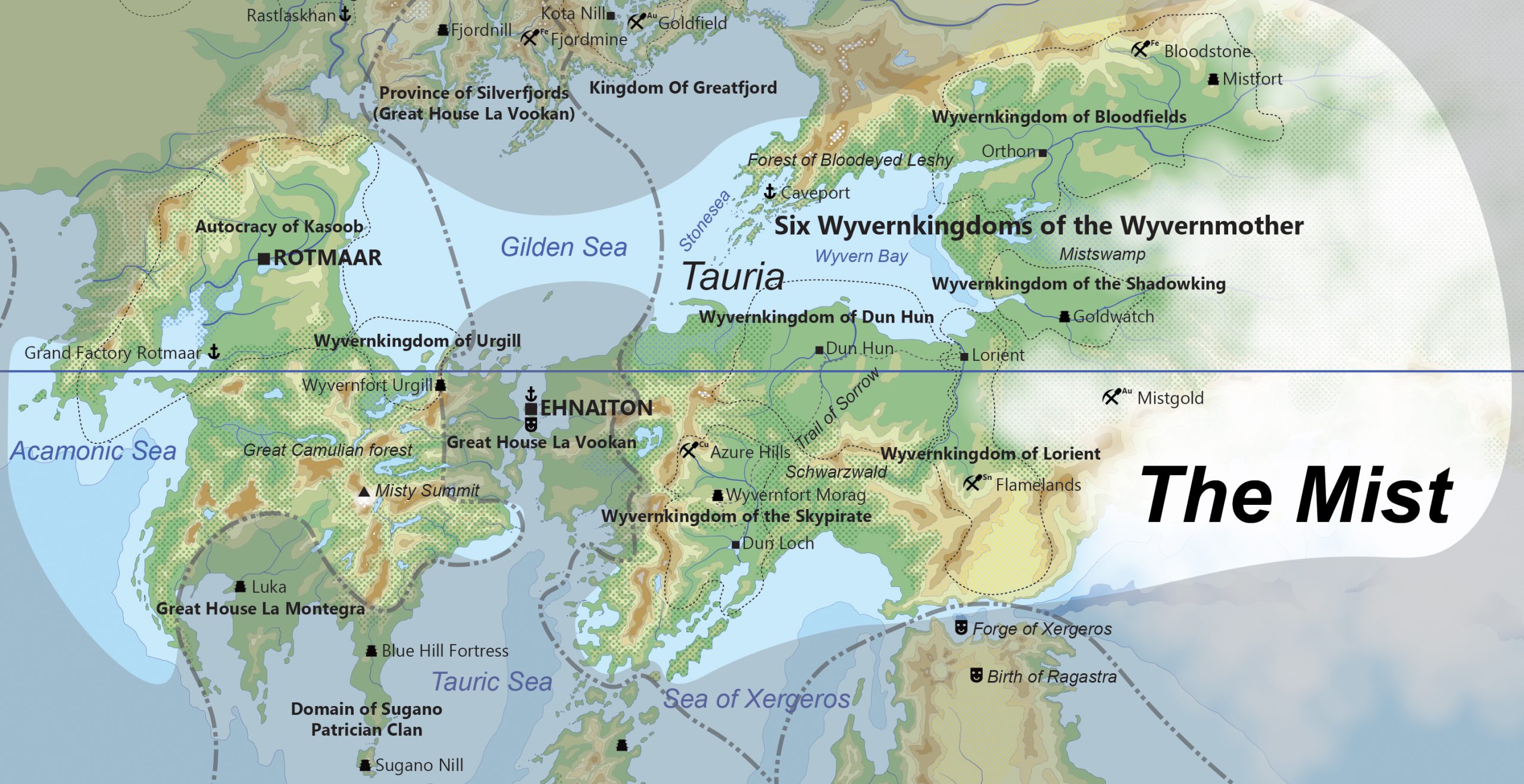This post is an example of how Trade Regions are depicted in the SAKE Full Book.
Each of the 12 Trade Regions covered in the book will have similar pages, including:
- Base stats such as population, area, etc.
- Description of the trade goods of the region and a small random table when pirating them.
- General description of the region, its inhabitants, their culture, religion, important NPCs, etc.
- Map of the region.
- Something else of interest in the region, such as the Mist for Tauric region (which is a separate blogpost in this case: https://sake.ee/the-mist/ )
Tauric Trade Region (Temperate Zone)

The Tauric people inhabit the shores of the Gilden Sea, comprising two distinct groups: the mountain tauri and the plains tauri. Mountain tauri, untouched by the Asteanic Empire, reside in mountain forests practising permaculture and hunting. In contrast, plains tauri were under Asteanic rule for centuries until recently gaining freedom with the use of a natural air force – Wyvernknights. They have adopted the Asteanic alphabet for their written language.
Taurics are renowned for their martial prowess, excellent metalworking, bravery, and melancholy captured in epic poems by their bards. Tauric people lacked the strict social hierarchy present in Asteanic society. All Taurics had the right to bear arms, own land, and move freely. However, this is changing in the Wyvernkingdoms, as these crucial military animals, an assurance against a more powerful Asteanic Empire, require an ungodly amount of food.
Asteans and Tauri share parts of their polytheistic religion, albeit with some differences in understanding their pantheons. The Taurics hold a great fear of the world’s end, prophesied to come from the east in the form of a massive fog inhabited by terrifying creatures, including Mist Dragons. This ominous fog is foreseen to consume Tauria and the entire world, signifying humanity’s end.
In the present day, mountain Tauri are organized into small mountain kingdoms, with numerous mountain kings due to their size. Many Taurics still live under the La Mepho-Delagrua’n Asteanic Empire, while those freed by the Wyvernmother reside in one of the six kingdoms ruled by her sons.
Sons and Kingdoms of Wyvernmother
(From oldest to youngest)

Wyvernkingdom of the Shadowking
Curstag the Shadowking is in his late seventies. Surrounded closely by the Mist, swamps, and forests, Curstag’s kingdom is the oldest Wyvernkingdom, its independence from the Asteanic Empire dating back to the time before Wyvernmother. When the once significant region of the empire’s gold mines, Mistgold, fell into the Mist over a hundred years ago, the local Taurics fought for their independence without much resistance from the Asteans.
Wyvernmother initiated her campaign against the Asteans right here in this kingdom, venturing into the Mist to the Mistgold region, from where she brought out great wealth to finance her first military campaign. Inspired by this, adventurers still venture into the Mist to reach the Mistgold gold mining area and bring out treasures – but few of these adventures succeed.
The Kingdom of the Shadowking has only 15 000 inhabitants and no real towns or cities – the king and only one company of Wyvernknights reside at the ruined old Asteanic river fortress Goldwatch.
Wyvernkingdom of Lorient
The second son, Dormac the Soulsmith, also known as “The Smith of Gods,” rules as the Wyvernking of Lorient. The king is renowned throughout the Tauric lands and beyond for his exceptional soulsmithing abilities. Dormac is so revered that when people wish to offer an exceptional gift to a god, they commission a magic item from him.
The Kingdom of Lorient, with a population of 100 000 and covering an area of 40 000 km2, is centred around the old Asteanic city of Lorient, which has a population of 12 000. The kingdom’s primary exports are tin, metalworks, and other Tauric trade goods. In recent years, relations with the Asteans have been peaceful, leading to flourishing trade.
In the south, the kingdom encompasses an empty desert plateau, particularly favoured by dangerous phoenix birds whose ashes are used to make a special makeup highly prized by the Asteanic nobility. Young Wyvernknights and other adventurers venture into this area to hunt these massive otherworldly birds made of fire – an extremely perilous undertaking.

Wyvernkingdom of Bloodfields
Railbert the Bloodeye, who is in his early sixties, arguably holds the greatest of the Wyvernkingdoms – the Wyvernkingdom of Bloodfields. Railbert’s kingdom is the largest (approximately 100 000 km2) and most populous (with around 300 000 people, 15 000 of whom live in the city of Orthon). The Wyvernkingdom of Bloodfields has a fully developed feudal system with Wyvernknights at the top, Landsknights second, and commoners and serfs after them – quite similar to the Asteanic system, just a bit simpler (and replace samurais with Landsknights). Also, the Wyvernkingdom of Bloodfields has somewhat normalized relations with the Asteans, with many Asteanic merchants living in Orthon (which is an old Asteanic city). Bloodfields exports a considerable amount of iron, all sorts of steel products, and other Tauric region trade goods to the Asteanic World trade system.
The city of Orthon is a self-governing city governed by local trade and craft syndicates and representatives of the king.
Railbert holds his court at Mistfort – a huge mountain fortress built to house 200 wyverns, Wyvernknights, their families, servants and all sorts of officials. Railbert is known to be the only king who takes the threat of the Mist more scientifically and is actively trying to find a solution to the encroaching Mist. He regularly sends adventure parties into the Mist and has hired a great number of mages and metaphysicists from all over the world to find a way to stop it.
For reasons unknown to the public, the local nature god – The Bloodeyed Leshy – hates the king and his dynasty and has cursed him and his children with blindness and blood running from their eyes.

Wyvernkingdom of Urgill
Wyvernking Wynter the Singer rules over the small Wyvernkingdom of Urgill, with a populace of only 25 000 and just three companies of Wyvernknights protecting it. Wynter conquered his kingdom from some Asteanic landowners around 40 years ago with a small band of Wyvernknights. The kingdom is situated on the western coast of the Gilden Sea and is far away from the lands of his brothers.
Currently, Winter enjoys somewhat normal relations with nearby Asteans and rarely takes part in his mother’s military campaigns. Wynter resides at Wyvernfort Urgill, loosely governing the local lands. His wyverns pose a significant challenge for the local populace, who must make their living farming the poor, swampy soils of the area. The king and his knights are hated and feared, but they themselves are not malicious – the wyverns simply have voracious appetites for meat.
As the king is somewhat impoverished and faces no imminent threats to his power, it may be possible to convince him to hire out his Wyvernknights as mercenaries or even to conquer his kingdom from him.

Wyvernkingdom of Dun Hun
Wyvernking Urrigan the Warrior rules over the Wyvernkingdom of Dun Hun, which has been at the forefront of the war against the Asteanic Empire for decades. The kingdom has endured cycles of destruction and reconstruction, leaving it now dotted with duns – circular fortified hilltowns.
The plains Tauri of Dun Hun have adopted a warrior culture akin to that of mountain Tauri. In Dun Hun, everyone is free and expected to take up arms when the king goes to war. Despite its population of 240 000 and a land area of 60 000 km2, the kingdom can muster an army of almost 20 000 warriors – a considerable force relative to its population.
How is this possible? Firstly, Dun Hun receives substantial subsidies in the form of food and arms from other Wyvernkingdoms. The kingdom has been the primary battleground in the fight for independence for decades, and supporting Dun Hun has helped to maintain the integrity of other kingdoms.
However, there is also a darker aspect to this situation. Many farms in the kingdom are operated by slaves, with Dun Hun being the main customer for Morag the Skypirate and the pirates of Caveport in the slave trade. They even purchase slaves from Rastlaskhan in the Zuharic lands. The slave raids around the Gilden Sea are solely attributable to the Wyvernkingdom of Dun Hun. Warriors from Dun Hun frequently conduct raids into Asteanic territories and even Tauric mountain kingdoms to procure slaves.
Wyvernkingdom of the Skypirate
Wyvernking Morag the Skypirate rules over a Wyvernkingdom despised by all Asteanic and Tauric merchants, as well as by his own people. There isn’t much one can do when wyvernpirates descend from the sky to your ship, plunder everything, and sell you into slavery – and Morag doesn’t discriminate – the days of freedom fights against the Asteans are over for him, now everybody is fair game.
Skypirate isn’t a good king, as he treats his subjects just as poorly as his victims. Although the region he rules over is large (approximately 30 000 km2) and historically populous (though today only about 90 000 inhabitants), in reality, he resides with 200 wyverns, 100 wyvernpirates and their families, and numerous other lackeys in isolation within his impregnable Wyvernfort, which is brimming with plundered wealth. His wyverns roam freely over his lands, raiding the herds of local farmers or even killing them outright – such a horde of wyverns requires a vast amount of meat every day. Life in the Wyvernkingdom of Skypirate is like hell on earth, but at least nobody collects taxes.
With the copper mining area of Azure Hills abandoned, the city of Dun Loch (with 10 000 inhabitants) constantly fighting for survival, and the kingdom essentially rulerless, this area could be a good place for adventurous types to start their own kingdom – if only they could eliminate the pirate king. Of course, if successful, revenge or some backlash from his brothers is to be expected.
The youngest son Wyvernprince Fergus the Thundersinger is in his fifties and doesn’t have a kingdom jet(!).
Wyvernmother herself visits each of her sons in turns, living with them as she travels in the form of a Gigantic Quasicorporeal Wyvern.
Autocracy of Kasoob
The Autocracy of Kasoob stands out in the Tauric region as a peculiar entity – it is primarily settled by the Acamonic people who migrated there hundreds, if not thousands, of years ago from their homeland across the Acamonic Sea.
Ruled by the priesthood of the Acamonic fertility deity, Kasoob, the state appears to thrive under its leadership. Despite the swampy terrain and poor soils, the Autocracy of Kasoob enjoys prosperity and a sizable population (400 000 inhabitants, with 75 000 of them residing in the city of Rotmaar). Essentially functioning as a large city-state, the hinterlands serve primarily to support the grand temple-city.
The Autocracy of Kasoob remains largely isolated from the outside world. Trade with them is monopolized by the Asteanic Great House La Severin, which controls The Grand Factory Rotmaar. Consequently, there is little room for other merchants, and it is known that the state is not particularly fond of tourist travellers.
Mist is a separate blogpost in this case: https://sake.ee/the-mist/

































